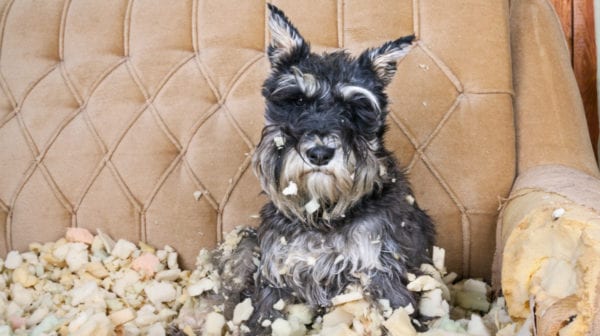Some dogs just love to dig! While this habit may be cute when they’re puppies, as dogs get older and grow bigger, it can be downright destructive—and expensive, especially if they’re digging your furniture. So, what can you do about dogs scratching the furniture?
While putting a pet couch cover or dog blankets on your couch may help, committed dig-aholic dogs can effectively rearrange them. Serious cases result in destroyed property and sometimes a vet bill from broken teeth or swallowed couch stuffing.
The answer to dogs scratching furniture often goes beyond a dog-proof couch. To solve the problem, pet parents must understand what prompts the digging in the first place.
Why Do Dogs Dig on Furniture?
Some breeds of dogs bred to “go to ground” inherited the digging behavior. Terriers and Dachshunds, for instance, were developed to root out critters that live underground in burrows. Digging is a natural and expected behavior for them.
Northern breeds like Siberian Huskies yearn to dig and create safe, comfy places to sleep. These breeds burrow into the snow for warmth or scoop out beds in the soil for cool nap spots.
Breed heritage isn’t the only reason dogs dig. Just as humans might search beneath sofa cushions for lost change, your dog may sniff out stray bits of popcorn and want to dig it out.
Some dogs cache important objects and use the couch to hide their favorite dog toys and protect them from being swiped. Other canines rearrange and fluff the bed like humans plump pillows before a nap.
You won’t like this reason, but it must be said; if your furniture fosters fleas or other bugs, they may target your canine buddy and you wouldn’t know. Dogs scratching furniture seek to eliminate or find those biting bugs or creepy-crawly sounds.
Finally, some dogs with nothing better to do decide to dig on furniture out of boredom.
In many cases, though, we unintentionally reward the behavior. Laughing at puppy antics or turning the dig behavior into a “stop-that” chase game can develop a habit. For an attention-seeking pup, even a “stop-it” chase game is more fun than being ignored.
How to Stop Your Dog from Digging Furniture
Different training techniques work for the specific causes that prompt the digging. You also must decide if you want your dog to share sofa time with you or if prefer he keep all four paws on the floor.
At our house, we offer our pup, Bravo, time on the “legal” sofa as a reward for good behavior. That means finding ways to allow him access without risking expensive furniture damage.
Here are some tips to stop or dissuade your diggidy-dog from destroying the couch. You may need to use more than one in combination to find the best choice for your pup.
Go-to-Ground Hounds
When you share your love (and pillow) with a holy terrier-type dog, you will NOT stop the digging behavior. Instead, give your dog an outdoor digging area so his frustration doesn’t target the upholstery. Build him an outdoor sandbox, for instance, and let him watch you bury a favorite toy and then dig in the sand.
You can create indoor digging opportunities by filling a large cardboard box with shredded newspaper or old cloth towels. This can help relieve doggy frustration and spare your couch.
Hot Dogs
If your dog is a northern breed seeking cool resting spots, offer him a chilly canine bed instead. Couple this with the outdoor sandbox outside, mentioned above.
For an indoor option, think outside the box with a couple of old, clean sheets. Put them in the freezer overnight, and use the chilled sheets as a cover on your existing pet bed. There also are dog beds like K&H cool bed III that are designed to help cool off hot dogs.
Foodie Sleuths
For pups sniffing out food, check the cushions for any crumbs left behind and vacuum thoroughly. Because I feed my cat, Karma, with puzzle toys hidden around the house, some of the kibble spills into the upholstery. Bravo quickly shows me the error of my ways.
Bug Hunters
Your canine companion should be protected from irritating and often dangerous parasites, and that protection helps prevent furniture infestation. Invest in pet-safe products to treat your furniture and home.
Couch Stashers
When your dog wants to hide dog treats or toys, offer him a better option than the couch. For instance, make his favorite chew toy—spiked with peanut butter or another yummy filler—available only inside his crate. Associate the toy or treat with a different location, so he heads that way instead of making the couch his secret stash.
Bored Dogs
Pups left alone for hours at a time easily become bored with nothing else to do. Offer him a job to do, like sniffing out hidden toys or treats. Dog interactive toys also help keep him occupied and engaged. Just keep the prizes away from your couch!
Attention Seekers
When your pooch uses couch digging to get your attention, find another way to reward him. It can be tough, but IGNORE the digging, and only give him attention when he asks in a preferred way. For example, teach him to sit to request your attention, or to bring you a favorite toy. That can be his puppy currency to pay you for what he wants.
How to Protect Your Furniture
It may take time to teach your dog new rules. Be patient and ALWAYS give dogs a legal option.
Meanwhile, here are five tips to keep your furniture safe and create a dog-proof couch:
- Set up dog gates, like Carlson’s Walk-Thru dog gate to prevent your pup access to the affected area.
- Place a plastic carpet runner nub-side-up on the cushion
- Use a cat tape, such as SmartyKat scratch not tape on cushions
- Invest in a commercial pet repellent product, like PetSafe’s SSScat deterrent spray, to keep dogs off furniture.
- Purchase couch covers, like K&H’s Furniture Cover, or use a sheet or dog blankets.
By tackling odors in your home by using dog odor absorbers and odors on your pet, it won’t be long before you not only love just your dog, but how he smells, too.
Share:














